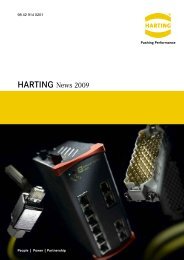Download - Harting
Download - Harting
Download - Harting
Create successful ePaper yourself
Turn your PDF publications into a flip-book with our unique Google optimized e-Paper software.
Bottleneck in the output port:<br />
If the output port of a switch is saturated with messages,<br />
high priority automation protocols also have to wait for port<br />
release (see fig. 3). A low priority message with a length<br />
of 1500 bytes leaves the output port. The high priority<br />
automation message then has to wait up to 125 μsec for<br />
port release.<br />
μsec<br />
0<br />
10<br />
20<br />
30<br />
40<br />
50<br />
60<br />
70<br />
80<br />
90<br />
100<br />
110<br />
120<br />
Fast Track<br />
Switching<br />
Store & Forward<br />
Switching<br />
Fig. 3: The effect of a low-priority protocol in the output port on<br />
automation protocols<br />
If traffic in the network is very low, then only the Ethernet<br />
transmission rate, the message length and the switch<br />
latency periods determine the message transition delay.<br />
In this example, the minimum message transition delays<br />
are approx. 160 μsec. If the load in the Ethernet network<br />
increases, this results in delays in the input ports and also<br />
bottlenecks in the output ports of the switches. If a very<br />
long message leaves an output port on the above route<br />
and if a high-priority automation message is to leave the<br />
switch on the same port, the automation message has to<br />
wait for the release of the port. Statistically, this effect<br />
can be repeated on the route and culminate in several<br />
milliseconds. In a line, all it takes is for this to occur at<br />
one switch while both messages travel along the route:<br />
The automation message always follows the long message<br />
and, each time, it has to wait until it has left the ports; it<br />
can no longer overtake on the route. The probability of<br />
this undesired effect grows with the load in the network.<br />
With just 16 switches, message transition delays of several<br />
milliseconds occur.<br />
The determinism required in automation is therefore not<br />
guaranteed with today’s switching technology. IT protocols<br />
lead to delays for automation protocols. These delays<br />
accumulate in line topologies.<br />
Deterministic Ethernet<br />
with fast track switching<br />
The principle of fast track switching offers a solution to<br />
this problem. The fast track switch detects automation<br />
protocols in order to pass these on with priority over all<br />
other protocols. In this way, it gives automation priority<br />
over other applications on Ethernet. The fast track switch<br />
accelerates all detected automation messages using the<br />
integrated cut-through method and prevents delays.<br />
Moreover, with fast track switching, automation messages<br />
could overtake other messages if the latter are occupying a<br />
required port. This means there are no “waiting times”. If<br />
an IT message is being sent and the port is occupied by an<br />
automation message, the forwarding of the IT message is<br />
terminated in a controlled manner so that the automation<br />
message can be forwarded directly according to the cutthrough<br />
method. The buffered IT message is then passed<br />
on. Fast track switching guarantees message transition<br />
delays at a higher performance than today’s field bus<br />
systems.<br />
Comparison of switching technologies<br />
Fast track switching also has to become established in<br />
the technological environment. Today’s established storeand-forward<br />
switching is the benchmark in terms of<br />
universality. Worldwide, there are an immense number<br />
of devices with Ethernet interfaces. All these devices can<br />
be linked via the store-and-forward mode. Not all of these<br />
devices are relevant for automation. However, innovations<br />
in automation are generally triggered via new technologies<br />
that are integrated into new devices. In this way, the topics<br />
of vision and RFID are not derived from classic automation.<br />
The devices do not generally support automation-specific<br />
technologies. However, as a rule, they have an Ethernet<br />
interface. Consequently, openness to standard Ethernet<br />
also means openness to innovations.<br />
Another effect is that fast track switching can also be used<br />
for all automation profiles that support standard Ethernet<br />
3<br />
13





